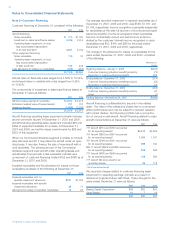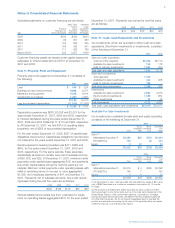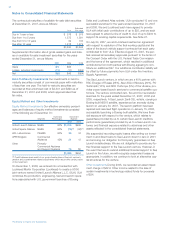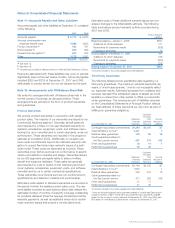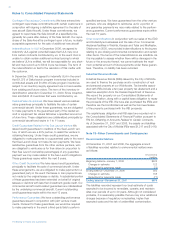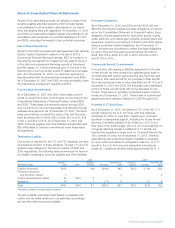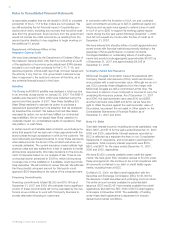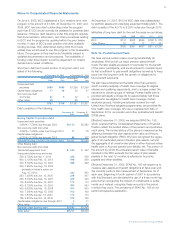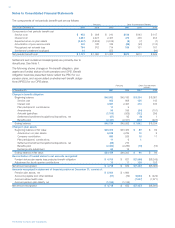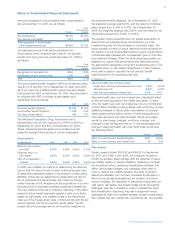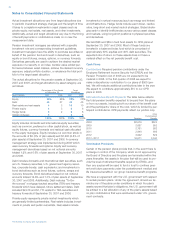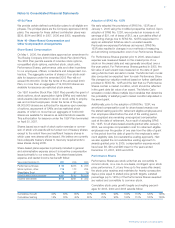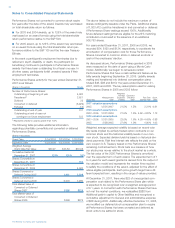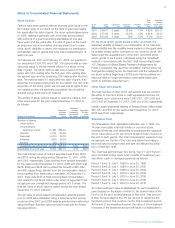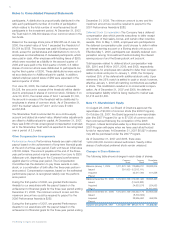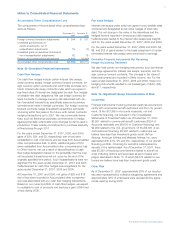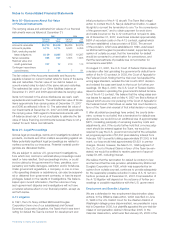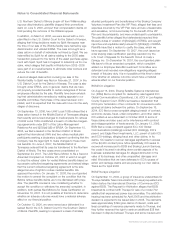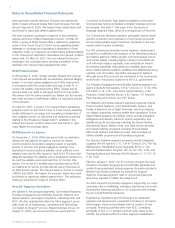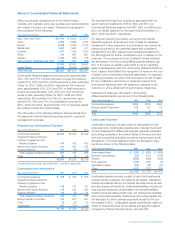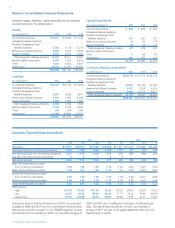Boeing 2007 Annual Report Download - page 69
Download and view the complete annual report
Please find page 69 of the 2007 Boeing annual report below. You can navigate through the pages in the report by either clicking on the pages listed below, or by using the keyword search tool below to find specific information within the annual report.
66
Notes to Consolidated Financial Statements
Actual investment allocations vary from target allocations due
to periodic investment strategy changes and the length of time
it takes to complete investments in asset classes such as
private equity, real estate, real assets, and other investments.
Additionally, actual and target allocations vary due to the timing
of benefit payments or contributions made on or near the
measurement date.
Pension investment managers are retained with a specific
investment role and corresponding investment guidelines.
Investment managers have the ability to purchase securities on
behalf of the pension fund and invest in derivatives, such as
equity or bond futures, swaps, options, or currency forwards.
Derivatives generally are used to achieve the desired market
exposure of a security or an index, transfer value-added per-
formance between asset classes, achieve the desired currency
exposure, adjust portfolio duration, or rebalance the total port-
folio to the target asset allocation.
The actual allocations for the pension assets at September 30,
2007 and 2006, and target allocations by asset category, are
as follows:
Percentage of Plan Assets Target
at September 30, Allocations
Asset Category 2007 2006 2007 2006
Equity 38% 55% 28% 28%
Debt 46 37 45 45
Real estate and real assets 4 3 10 10
Private equity 4 3 6 6
Hedge funds 3 2 6 6
Global strategies 55 5
100% 100% 100% 100%
Equity includes domestic and international equity securities,
such as common, preferred or other capital stock, as well as
equity futures, currency forwards and residual cash allocated
to the equity managers. Equity includes our common stock in
the amounts of $0 (0% of plan assets) and $1,260 (2.8% of
plan assets) at September 30, 2007 and 2006. A currency
management strategy was implemented during 2006 which
uses currency forwards and options. Equity and currency
management derivatives based on net notional amounts
totaled 1.9% and 6.6% of plan assets at September 30, 2007
and 2006.
Debt includes domestic and international debt securities, such
as U.S. Treasury securities, U.S. government agency securi-
ties, corporate bonds; cash equivalents; and investments in
bond derivatives such as bond futures, options, swaps and
currency forwards. Bond derivatives based on net notional
amounts totaled 16.6% and 7.0% of plan assets at September
30, 2007 and 2006. Additionally, Debt includes “To-Be-
Announced” mortgage-backed securities (TBA) and treasury
forwards which have delayed, future settlement dates. Debt
included $2,478 and $1,770 related to TBA securities and
treasury forwards at September 30, 2007 and 2006.
Private equity represents private market investments which
are generally limited partnerships. Real estate includes invest-
ments in private and public real estate. Real assets include
investments in natural resources (such as energy and timber)
and infrastructure. Hedge funds include event driven, relative
value, long-short and market neutral strategies. Global strate-
gies seek to identify inefficiencies across various asset classes
and markets, using long-short positions in physical securities
and derivatives.
We held $96 and $89 in trust fund assets for OPB plans at
September 30, 2007 and 2006. Most of these funds are
invested in a balanced index fund which is comprised of
approximately 60% equities and 40% debt securities. The
expected rate of return on these assets does not have a
material effect on the net periodic benefit cost.
Cash Flows
Contributions Required pension contributions under the
Employee Retirement Income Security Act (ERISA) and the
Pension Protection Act of 2006 are not expected to be
material in 2008. In the first quarter of 2008 we expect to
make a discretionary contribution to our plans of $500 (pre-
tax). We will evaluate additional contributions later in the year.
We expect to contribute approximately $15 to our OPB
plans in 2008.
Estimated Future Benefit Payments The table below reflects
the total pension benefits expected to be paid from the plans
or from our assets, including both our share of the benefit cost
and the participants’ share of the cost, which is funded by par-
ticipant contributions. OPB payments reflect our portion only.
Other
Postretirement
Pensions Benefits
2008 $2,576 $524
2009 2,657 553
2010 2,751 582
2011 2,848 609
2012 2,922 622
2013 – 2017 16,571 3,340
Termination Provisions
Certain of the pension plans provide that, in the event there is
a change in control of the Company which is not approved by
the Board of Directors and the plans are terminated within five
years thereafter, the assets in the plan first will be used to pro-
vide the level of retirement benefits required by ERISA, and
then any surplus will be used to fund a trust to continue pres-
ent and future payments under the postretirement medical and
life insurance benefits in our group insurance benefit programs.
We have an agreement with the U.S. government with respect
to certain pension plans. Under the agreement, should we ter-
minate any of the plans under conditions in which the plan’s
assets exceed that plan’s obligations, the U.S. government will
be entitled to a fair allocation of any of the plan’s assets based
on plan contributions that were reimbursed under U.S. govern-
ment contracts.
The Boeing Company and Subsidiaries


